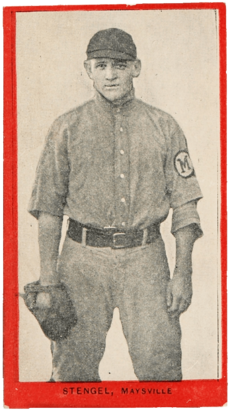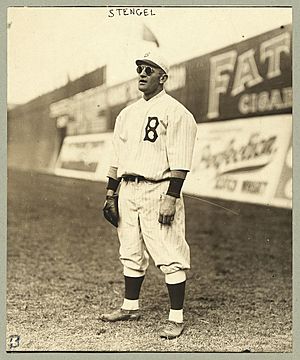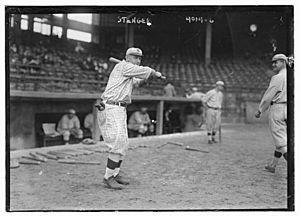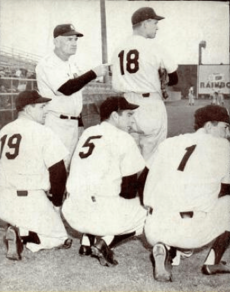Casey Stengel facts for kids
Quick facts for kids Casey Stengel |
|||
|---|---|---|---|
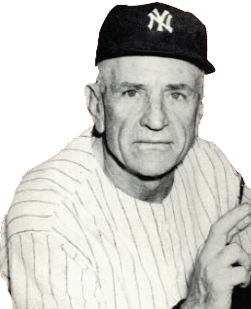
"The Ol' Perfesser" in 1953
|
|||
| Right fielder / Manager | |||
| Born: July 30, 1890 Kansas City, Missouri, U.S. |
|||
| Died: September 29, 1975 (aged 85) Glendale, California, U.S. |
|||
|
|||
| debut | |||
| September 17, 1912, for the Brooklyn Dodgers | |||
| Last appearance | |||
| May 19, 1925, for the Boston Braves | |||
| MLB statistics | |||
| Batting average | .284 | ||
| Home runs | 60 | ||
| Runs batted in | 535 | ||
| Managerial record | 1,905–1,842 | ||
| Winning % | .508 | ||
| Teams | |||
|
|||
| Career highlights and awards | |||
|
|||
| Induction | 1966 | ||
| Election Method | Veterans Committee | ||
Charles Dillon "Casey" Stengel (born July 30, 1890 – died September 29, 1975) was an American Major League Baseball player and manager. He was famous for being the manager of the amazing New York Yankees teams in the 1950s. Later, he managed the new New York Mets. People called him "The Ol' Perfessor" because he was so smart about baseball. He was voted into the Baseball Hall of Fame in 1966.
Casey Stengel was born in Kansas City, Missouri, in 1890. He started playing professional baseball in 1910, and his career lasted over 50 years! After playing in the minor leagues for a few years, Stengel joined the major leagues in 1912 as an outfielder for the Brooklyn Dodgers. He played well for six seasons, even helping Brooklyn win the National League championship in 1916. But he also became known for his funny antics.
After some disagreements about pay, Stengel was traded to the Pittsburgh Pirates in 1918. He then joined the Navy for the rest of World War I. When he came back to baseball, more pay disagreements led to trades to the Philadelphia Phillies (in 1919) and the New York Giants (in 1921). With the Giants, he learned a lot from manager John McGraw. He had some great moments, like hitting an inside-the-park home run in the 1923 World Series against the Yankees. His playing career ended with the Boston Braves in 1925, and he then started managing teams.
Casey Stengel managed for 20 years, but his teams often didn't do very well, especially his major league teams like the Dodgers (1934–1936) and Braves (1938–1943). But he found success in the minor leagues. In 1948, general manager George Weiss hired him to manage the New York Yankees. Stengel's Yankees won the World Series five times in a row (1949–1953)! No other team has ever done that. His teams won ten league championships in his twelve seasons and seven World Series. In his last two years, the Yankees didn't win the World Series. At 70 years old, he was let go by the Yankees after they lost the 1960 World Series.
Stengel became famous for his funny and sometimes confusing way of talking, called "Stengelese." These showman skills were perfect for the new New York Mets team when they hired him in 1961. He worked hard to promote the team, even though they had a tough time winning games. The Mets finished last in all four years he managed them, but fans loved them anyway. Stengel retired in 1965 and stayed a popular figure in baseball. Many people remember Casey Stengel as one of baseball's greatest characters.
Contents
- Casey's Early Life
- Playing Baseball Career
- Casey's Early Managerial Career (1925–1948)
- Glory Days: The Yankee Dynasty (1949–1960)
- The Amazin' Mets: Casey's Last Team (1962–1965)
- Later Years and Passing
- Casey's Managerial Record
- Awards and Honors
- Casey's Managing Style
- How People Remember Casey
- Images for kids
- See also
Casey's Early Life
Charles Dillon Stengel was born on July 30, 1890, in Kansas City, Missouri. His parents, Louis and Jennie Stengel, moved to Kansas City before he was born. Charlie was the youngest of three children.
As a child, Charlie Stengel loved playing sandlot baseball. He also played baseball, football, and basketball at Central High School in Kansas City. His basketball team won the city championship, and his baseball team won the state championship!
When he was a teenager, Stengel played for several semipro baseball teams. He played for the Kansas City Red Sox in 1908 and 1909, traveling as far as Wyoming and earning a dollar a day. He was offered a contract by the minor league Kansas City Blues for $135 a month, which was more money than his father made. Since Charlie was underage, his father had to agree, and he did.
Playing Baseball Career
Minor League Days
Before joining the Kansas City Blues in 1910, Stengel got advice from his neighbor, Kid Nichols, a famous pitcher. Nichols told him to listen to his manager and older players. Stengel didn't make the Blues team right away. He was sent to a lower-level minor league team, the Kankakee Kays, to get more experience as an outfielder. He also played for the Shelbyville Grays, who later became the Maysville Rivermen.
Not sure if baseball would work out, Stengel went to dental school in the offseason. He would later joke about trying to be a left-handed dentist with right-handed tools! The Blues then sold Stengel to the Aurora Blues. He played very well there, leading the league with a .352 batting average. A Brooklyn Dodgers scout saw him play, and the Dodgers bought his contract in 1911. Stengel finished the season with Aurora and went back to dental school for another offseason. He never graduated, but his wife, Edna, would often tell him to get his degree if his baseball career hit a rough patch.
In 1912, the Dodgers sent Stengel to the Montgomery Rebels. He batted .290 and was known for being a bit unusual. After playing a little with the Dodgers in September, he spent a third offseason at dental school.
Playing for Brooklyn (1912–1917)
Casey Stengel loved to tell stories about his early days with the Brooklyn Dodgers. He made his major league debut on September 17, 1912. He played center field and had a great first game, getting four hits and helping Brooklyn win. He finished the season with a .316 batting average.
In 1913, Stengel became the starting center fielder for the Dodgers. They had a new ballpark, Ebbets Field, and Stengel was the first player to hit a home run there! During this year, he got the nickname "Casey," likely because he was from Kansas City (K.C.). He hit .272 with 7 home runs in his first full season. Before the 1914 season, Stengel coached baseball at the University of Mississippi. He was called an "assistant professor" there, which might be where his other nickname, "The Ol' Perfessor," came from.
The Dodgers got better each year Stengel was with them. Their manager, Wilbert Robinson, had a big influence on Casey. In 1914, Stengel's salary almost doubled to $4,000 a year. He finished that season with a .316 batting average, one of the best in the league. He even led the league in on-base percentage at .404.
In 1915, Stengel was part of a famous prank during spring training. Manager Robinson agreed to catch a baseball dropped from an airplane. But it turned out to be a grapefruit! Stengel often retold this story, sometimes saying he was the one who dropped the grapefruit.
In 1916, the Dodgers became one of the best teams in the league. Stengel, playing mostly right field, hit .279 with eight home runs. His home run on September 30 helped the Dodgers take first place and qualify for their first World Series against the Boston Red Sox. Stengel played well in the Series, getting hits in the games he played.
Even after a successful season, the Dodgers' owner wanted to cut Stengel's salary. After some disagreements, Stengel signed for less money in 1917. His batting average dropped, but he still led the team in many categories. In January 1918, the Dodgers traded Stengel to the Pittsburgh Pirates.
Pittsburgh and Philadelphia (1918–1921)
The Pirates were not doing well when Stengel joined them. He argued with the umpire in one game and was fined for taking off his shirt on the field. Soon after, Stengel joined the Navy during World War I. He played for and managed the Brooklyn Navy Yard's baseball team.
After the war, Stengel continued to have salary disagreements. He was traded to the Philadelphia Phillies in August 1919. Before this trade, Stengel pulled one of his most famous stunts. While playing for the Pirates at Ebbets Field, he found a sparrow. When it was his turn to bat, he quietly put the bird under his cap. He bowed to the crowd, took off his cap, and the bird flew away, making everyone laugh!
Stengel refused to play for the Phillies until he got a raise. He eventually agreed and hit .292 with nine home runs in 1920. But injuries kept him from playing much in early 1921. In June 1921, the Phillies traded Stengel to the New York Giants.
New York Giants and Boston Braves (1921–1925)
When Stengel joined the Giants, they were managed by John McGraw, one of baseball's most respected managers. Stengel learned a lot from McGraw. He didn't play much in 1921, mostly watching as the Giants won the National League championship. He was on the team for the 1921 World Series but didn't play.
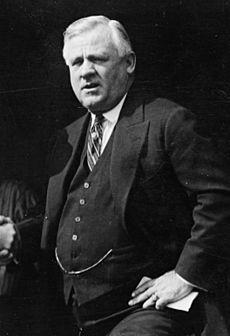
In 1922, Stengel worked hard in spring training and earned a spot as a reserve outfielder. He played well when the Giants needed him, hitting .368 in 84 games. The Giants played the Yankees again in the 1922 World Series and won. After the Series, Stengel went on a baseball tour to Japan.
The 1923 season was similar. Stengel played well when he got the chance, hitting .339. The Giants and Yankees both won their leagues, setting up another World Series match.
Game 1 of the 1923 World Series was at the new Yankee Stadium. In the ninth inning, with the score tied, Casey Stengel hit a ball deep into the outfield. Even with a leg injury, he slowly ran around the bases for an inside-the-park home run! This was the first World Series home run ever hit in Yankee Stadium, and it won the game for the Giants.
In Game 3, Stengel hit another home run, winning the game 1–0. When Yankee fans booed him, he made a funny gesture, which made the Yankees' owner angry. But the Baseball Commissioner said Stengel was just being playful. The Yankees won the next three games to take the Series. Stengel batted an amazing .417 in the six games.
In November 1923, Stengel was traded to the Boston Braves. He was sad to leave New York and his mentor, McGraw. But he soon settled in. He played in 134 games in 1924, hitting .280. After the season, Stengel and his wife, Edna, went on a baseball tour of Europe. They met King George V and Queen Mary! That winter, the Stengels moved into a house in Glendale, California, where they lived for the rest of their lives.
Casey's Early Managerial Career (1925–1948)
Minor League Manager (1925–1931)
Stengel started the 1925 season with the Braves but didn't play much. His batting average was very low. The Braves' owner bought a minor league team, the Worcester Panthers, and hired Stengel as their player-manager and team president. Stengel was a big draw for fans in the Eastern League because of his funny actions and World Series fame. He hit .302 in 100 games, and the Panthers finished third.
Stengel wanted to manage a higher-level team, the Toledo Mud Hens. After some tricky moves, he left the Panthers and became the manager of the Mud Hens in 1926. He managed in Toledo for six years, his longest time with any team until the Yankees. In 1927, his team won its league championship and then the Little World Series. Stengel even hit a game-winning home run for the Mud Hens in 1927, his last professional home run. The team's success didn't last, and they struggled in later years. Stengel and the team faced financial problems due to the Great Depression. He was fired in 1931.
Managing in Brooklyn and Boston (1932–1943)
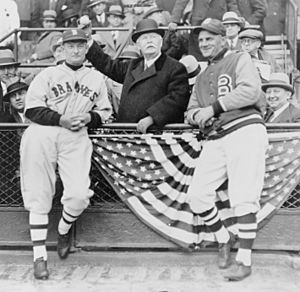
Stengel became the first base coach for the Brooklyn Dodgers in 1932, returning to the major leagues after seven years. Some people thought his funny reputation kept owners from hiring him as a manager, even though he was very smart about baseball.
In 1934, Stengel became the manager of the Dodgers. He had little time to prepare his team, and they finished in sixth place. Stengel loved to tell a story from 1934 about a game in Philadelphia. His pitcher, Boom-Boom Beck, threw the ball into right field instead of giving it to Stengel. The right fielder, Hack Wilson, thought it was a hit and ran to get it, making everyone laugh. Stengel also got the last laugh on the Giants that year. The Giants had a big lead, but Brooklyn beat them in the last two games of the season, helping the Cardinals win the championship instead of the Giants.
The Dodgers finished fifth in 1935 and seventh in 1936. Stengel was fired after the 1936 season. He didn't work in baseball in 1937. During this time, he invested in oil properties, which made him and his wife, Edna, quite wealthy. In late 1937, he was offered the Boston Braves managerial job, and he accepted.
Stengel managed the Braves for six years, from 1938 to 1943. His teams never finished in the top half of the league. Many top players went to serve in World War II, but it didn't change the Braves' standing much. One young player, pitcher Warren Spahn, was sent to the minor leagues by Stengel. Spahn later became a Hall of Famer and joked that he was the only one to play for Stengel before and after he was a "genius."
In 1943, Stengel was hit by a car and broke his leg. He missed the first two months of the season and walked with a limp for the rest of his life. At the end of the season, the Braves fired Stengel. He didn't get any immediate job offers.
Back to the Minors (1944–1948)
Stengel thought 1943 would be his last year in baseball. But in 1944, the minor league Milwaukee Brewers needed a manager. The team owner, Bill Veeck, wasn't sure about Stengel at first. But Stengel was good with reporters, and his talented team started winning. The Brewers won their league championship that year.
In 1945, Stengel took a job managing the Kansas City Blues, a Yankee farm team in his old hometown. The Blues didn't do well, finishing seventh.
Then, Stengel got an offer from the Oakland Oaks in the Pacific Coast League. This league was almost as good as the major leagues, and it had three teams in Southern California, letting Stengel spend more time at home. The Oaks had not won much before, but the owner believed Stengel could make them a winning team.
The Oaks finished second in 1946 and fourth in 1947. In 1948, Stengel managed the Oaks for a third year. The team had many former major leaguers and some talented young players, like 20-year-old shortstop Billy Martin. Stengel was very impressed with Martin's skills. The Oaks won their league championship in 1948, and The Sporting News named Stengel the Minor League Manager of the Year.
Glory Days: The Yankee Dynasty (1949–1960)
Becoming the Yankees Manager (1949)
Stengel had been considered for the Yankee manager job before. After the Yankees finished third in 1948, their manager was fired. George Weiss, now the Yankees' general manager, pushed for Stengel to be hired. Stengel helped his own case by winning the championship with Oakland.
Stengel was introduced as the Yankees manager on October 12, 1948. This was 25 years after he hit his second World Series home run to beat the Yankees! Joe DiMaggio, the Yankees' superstar, was there to show support. Some people wondered if Stengel, known as a clown, would fit with the serious Yankees.
Stengel tried to stay quiet during spring training in 1949. But he was always moving players around and changing the lineup. The Yankees were not expected to win because DiMaggio was injured. Stengel had to be creative with his lineup because of all the injuries. He became famous for using "platooning," which means playing right-handed batters against left-handed pitchers and vice versa. This helped his team a lot.
After a tough loss in May, Stengel gave a speech to his team, criticizing them but also telling them they would be great. The team then won 13 of their next 14 games. DiMaggio returned from his injury in June and helped the Yankees take the lead. The Boston Red Sox caught up to the Yankees by late September. The season came down to a two-game series against the Red Sox at Yankee Stadium. The Yankees had to win both games.
Stengel was good at using relief pitchers. In the first game, he brought in Joe Page, who helped the Yankees win 5–4. This set up a winner-take-all game for the league title. The Yankees took a 5–0 lead and held on to win, giving Stengel his first major league championship!
In the 1949 World Series, the Yankees played the Brooklyn Dodgers. The teams split the first two games. Stengel introduced his old teammates from the 1916 Brooklyn team, which was very emotional. The Yankees won Game 3. In Game 4, Stengel shouted to his catcher, Yogi Berra, to throw the ball to second base, which Berra did to catch a runner. The Yankees won Game 5 to take the Series. Everyone praised Stengel for his first World Series win as a manager.
Winning Again and Again (1950–1953)
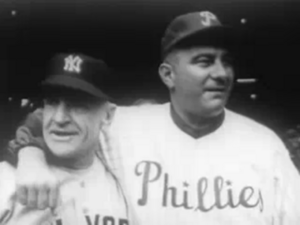
After winning the World Series, Stengel became more confident and talkative. He was also more forceful with his team, even with veteran players like DiMaggio. He tried to make DiMaggio play first base, but DiMaggio refused after one game. Stengel even benched DiMaggio for a few games to give him a rest. Young players like Billy Martin and Whitey Ford joined the team, and they accepted Stengel's methods. The Yankees won the pennant again in 1950. In the 1950 World Series, the Yankees beat the Phillies in four games.
In 1950, the Yankees started an "instructional school" for young players, which was Stengel's idea. In 1951, 19-year-old Mickey Mantle joined the team. Stengel moved Mantle from shortstop to the outfield. Both Mantle and the Yankees started slowly, but Mantle improved. Yogi Berra had an amazing season, winning the MVP award. The Yankees won their third straight pennant.
The Yankees faced the Giants in the 1951 World Series. The Giants won Game 1. In Game 2, Mantle got a knee injury that would affect his career. The Giants won Game 3, but DiMaggio played great in the next three games, hitting a home run in his final season. The Yankees won Games 4 and 5. In Game 6, the Yankees held on to win, giving Stengel his third straight World Series championship!
After DiMaggio retired in 1951, Stengel had even more control over the team. He moved Mantle to center field. Many people didn't think the Yankees would win the pennant in 1952 because DiMaggio was gone and some players were in the Korean War. But Stengel used younger players he had helped develop, like Billy Martin at second base. Mantle also improved by the end of the season. The Yankees started slowly but got better, winning the pennant on September 27.
The 1952 World Series was against the Brooklyn Dodgers, who had stars like Jackie Robinson and Duke Snider. The teams split the first four games. Stengel used many pitchers in Game 7. Mantle hit a home run, and Martin made a great catch to save the lead. The Yankees won 4–2, their fourth straight World Series victory, matching a record!
In 1953, the sportswriters finally picked the Yankees to win, and they were right! An 18-game winning streak in June put them far ahead. They won their fifth straight league championship. The Yankees played the Dodgers again in the 1953 World Series, winning in six games. Players like Mantle, Martin, Berra, and Gil McDougald, who Stengel had helped develop, led the way. The Yankees and Stengel won the World Series for the fifth year in a row, a record that has never been broken!
Middle Years (1954–1958)
In 1954, the Yankees won 103 games, their most under Stengel, but they still lost the pennant to the Cleveland Indians. Even with the loss, Stengel got a new two-year contract.
By the mid-1950s, Stengel was a national celebrity. People saw him on TV during Yankee games and in the World Series. Magazines wrote stories about him, and his funny way of talking became known as "Stengelese." People loved the "grandfatherly fellow" whose humor was so different from the Yankees' serious image.
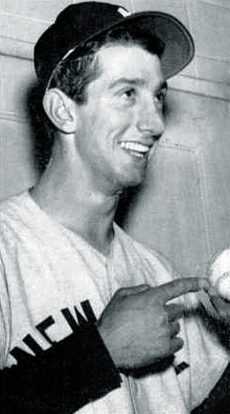
The Yankees won the pennant again in 1955. They played the Dodgers again in the World Series, but this time the Dodgers won in seven games. Stengel blamed himself for the loss.
In 1956, the Yankees easily won the pennant. Much attention was on Mantle, who hit 52 home runs and won the Triple Crown. Stengel made a tough decision by releasing Phil Rizzuto, a popular veteran, to make room for another player.
The World Series was again against the Dodgers. The Dodgers won the first two games. Stengel talked to his team before Game 3, and they responded by winning. In Game 5, Stengel started Don Larsen, who pitched a perfect game, the only one in World Series history! The Yankees won Game 7, 9–0, giving Stengel his sixth World Series championship as manager.
The Yankees started slowly in 1957. Stengel was close to Billy Martin, but the team owners traded Martin to another team. Stengel was sad about the trade.
The Yankees recovered and won the American League pennant by eight games. They faced the Milwaukee Braves in the 1957 World Series. The Braves beat the Yankees in seven games. Stengel was getting older, and some players felt he was more irritable. His contract was ending after the 1958 season. But the Yankees won the pennant again by 10 games. The Braves were the opponent in the 1958 World Series. The Braves won three of the first four games, but the Yankees came back to win the Series! Because of this comeback, Stengel was given another two-year contract.
Last Years and Leaving the Yankees (1959–1960)
In 1959, the Yankees had a tough year, finishing in third place. Many people criticized Stengel, saying he was too old and out of touch.
After the 1959 season, the Yankees got Roger Maris. Stengel loved Maris and put him high in the batting order. Maris had an amazing season in 1960. Stengel had some health issues during the year but still led the Yankees to their tenth pennant, tying a major league record! The Yankees played the Pittsburgh Pirates in the 1960 World Series. Stengel made some pitching choices that were questioned. The Pirates won Game 7 with a home run in the last inning.
Soon after the loss, Stengel was told he would not get a new contract. He asked for the news to be announced at a press conference. On October 18, 1960, Stengel told reporters, "Quit, fired, whatever you please, I don't care." The Yankees said he was being let go because of his age, 70.
The Amazin' Mets: Casey's Last Team (1962–1965)
Starting the Mets (1962)
After leaving the Yankees, Stengel spent 1961 out of baseball. He turned down other managing jobs. He worked as a vice president at a bank owned by his wife's family.
In the early 1960s, New York got a new baseball team, the New York Mets. They hoped the team would be popular with fans who missed the Giants and Dodgers, who had moved to California. George Weiss, who had left the Yankees, became the Mets' general manager. He wanted Stengel to manage the team. Stengel was introduced as the Mets manager on October 2, 1961.
The Mets were a new team, and the rules for picking players meant they wouldn't be very good at first. Weiss wanted Stengel to manage because he was famous and could attract fans. The Mets picked many older players who used to play for the Dodgers or Giants. Stengel famously said, "You have to have a catcher or you'll have a lot of passed balls," when explaining why they picked a catcher first.
Casey Stengel's return to spring training got a lot of attention. The Mets lost their first nine games of the regular season. They then lost 17 games in a row, ending up in last place, where they stayed all season.
The Mets became popular with younger fans. Even though they lost a lot, fans loved their funny moments. A favorite was Marv Throneberry, who often made mistakes. In one game, he hit a big shot and ended up on third base, but was called out for missing first base. Stengel argued, only to be told Throneberry had missed second base too!
Stengel worked tirelessly to promote the Mets. He often used the word "amazin'" to describe them, and soon they were called the "Amazin' Mets." He would tell fans, "Come out and see my amazin' Mets. I been in this game a hundred years but I see new ways to lose I never knew existed before." The Mets drew many fans, even though they finished with a record of 40 wins and 120 losses, the most losses of any 20th-century major league team.
Later Seasons and Retirement (1963–1965)
The 1963 season was much like 1962 for the Mets; they finished in last place again. One fun moment was when the Mets beat the Yankees in a special game at Yankee Stadium.
In 1964, the Mets moved into the new Shea Stadium. Stengel joked that "the park is lovelier than my team." The Mets finished in last place again. Fans were starting to get impatient with all the losing. Stengel was given a contract for 1965, but some people thought he should retire.
The 1965 season started with more losses. On July 25, Stengel fell and broke his hip. He didn't realize how badly he was hurt until the next day. Stengel spent his 75th birthday in the hospital. He knew he would need a lot of recovery, so he retired as manager of the Mets on August 30. The Mets finished in last place again that year.
Later Years and Passing
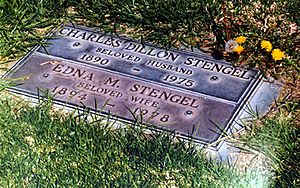
The Mets retired Stengel's uniform number, 37, on September 2, 1965. He moved back to his home in California. He was still paid by the team as a vice president, but he was mostly out of baseball. He often attended the World Series, the All-Star Game, and Mets spring training. Baseball writers decided he shouldn't have to wait the usual five years to be elected to the Hall of Fame. On March 8, 1966, Stengel was surprised with the news of his election. He was inducted in July, along with Ted Williams.
In 1969, the "Amazin' Mets" surprisingly won the 1969 World Series. Stengel attended the Series, threw out the first pitch for Game 3, and visited the clubhouse after the Mets won. They even gave him a championship ring!
In 1970, the Yankees invited Stengel to their Old-Timers' Day to retire his number, 37. He became the fifth Yankee to have his number retired. He then regularly attended the Yankees' Old-Timers' Day.
By 1971, Edna Stengel, Casey's wife, started showing signs of Alzheimer's disease. In 1973, she moved into a nursing home. Casey continued to live in his Glendale home. In his last year, Stengel's health declined. He was too ill to attend the Yankees' Old-Timers Day in August 1975. He was diagnosed with cancer and passed away on September 29, 1975.
Many people shared tributes to Stengel after his death. Maury Allen wrote, "He is gone and I am supposed to cry, but I laugh. Every time I saw the man, every time I heard his voice, every time his name was mentioned, the creases in my mouth would give way and a smile would come to my face." Richie Ashburn, a player for the 1962 Mets, said, "Don't shed any tears for Casey. He wouldn't want you to... He was the happiest man I've ever seen."
Edna Stengel passed away in 1978 and was buried next to Casey. There is a plaque near their graves that includes a funny quote from Stengel: "There comes a time in every man's life, and I've had plenty of them."
Casey's Managerial Record
| Team | Year | Regular season | Postseason | |||||||
|---|---|---|---|---|---|---|---|---|---|---|
| Games | Won | Lost | Win % | Finish | Won | Lost | Win % | Result | ||
| BKN | 1934 | 152 | 71 | 81 | .467 | 6th in NL | – | – | – | – |
| BKN | 1935 | 153 | 70 | 83 | .458 | 5th in NL | – | – | – | – |
| BKN | 1936 | 154 | 67 | 87 | .435 | 7th in NL | – | – | – | – |
| BKN total | 459 | 208 | 251 | .453 | 0 | 0 | – | |||
| BOB | 1938 | 152 | 77 | 75 | .507 | 5th in NL | – | – | – | – |
| BOB | 1939 | 151 | 63 | 88 | .417 | 7th in NL | – | – | – | – |
| BOB | 1940 | 152 | 65 | 87 | .428 | 7th in NL | – | – | – | – |
| BOB | 1941 | 154 | 62 | 92 | .403 | 7th in NL | – | – | – | – |
| BOB | 1942 | 148 | 59 | 89 | .399 | 7th in NL | – | – | – | – |
| BOB | 1943 | 107 | 47 | 60 | .439 | 6th in NL | – | – | – | – |
| BOB total | 864 | 373 | 491 | .432 | 0 | 0 | – | |||
| NYY | 1949 | 154 | 97 | 57 | .630 | 1st in AL | 4 | 1 | .800 | Won World Series (BKN) |
| NYY | 1950 | 154 | 98 | 56 | .636 | 1st in AL | 4 | 0 | 1.000 | Won World Series (PHI) |
| NYY | 1951 | 154 | 98 | 56 | .636 | 1st in AL | 4 | 2 | .667 | Won World Series (NYG) |
| NYY | 1952 | 154 | 95 | 59 | .617 | 1st in AL | 4 | 3 | .571 | Won World Series (BKN) |
| NYY | 1953 | 151 | 99 | 52 | .656 | 1st in AL | 4 | 2 | .667 | Won World Series (BKN) |
| NYY | 1954 | 154 | 103 | 51 | .669 | 2nd in AL | – | – | – | – |
| NYY | 1955 | 154 | 96 | 58 | .623 | 1st in AL | 3 | 4 | .429 | Lost World Series (BKN) |
| NYY | 1956 | 154 | 97 | 57 | .630 | 1st in AL | 4 | 3 | .571 | Won World Series (BKN) |
| NYY | 1957 | 154 | 98 | 56 | .636 | 1st in AL | 3 | 4 | .429 | Lost World Series (MIL) |
| NYY | 1958 | 154 | 92 | 62 | .597 | 1st in AL | 4 | 3 | .571 | Won World Series (MIL) |
| NYY | 1959 | 154 | 79 | 75 | .513 | 3rd in AL | – | – | – | – |
| NYY | 1960 | 154 | 97 | 57 | .630 | 1st in AL | 3 | 4 | .429 | Lost World Series (PIT) |
| NYY total | 1845 | 1149 | 696 | .623 | 37 | 26 | .587 | |||
| NYM | 1962 | 160 | 40 | 120 | .250 | 10th in NL | – | – | – | – |
| NYM | 1963 | 162 | 51 | 111 | .315 | 10th in NL | – | – | – | – |
| NYM | 1964 | 162 | 53 | 109 | .327 | 10th in NL | – | – | – | – |
| NYM | 1965 | 95 | 31 | 64 | .326 | retired | – | – | – | – |
| NYM total | 579 | 175 | 404 | .302 | 0 | 0 | – | |||
| Total | 3747 | 1905 | 1842 | .508 | 37 | 26 | .587 | |||
Awards and Honors
 |
|
| Casey Stengel's number 37 was retired by the New York Yankees in 1970. |
 |
|
| Casey Stengel's number 37 was retired by the New York Mets in 1965. |
In 1969, Casey Stengel was voted "Greatest Living Manager" as part of baseball's 100-year celebration. Both the Yankees and the Mets retired his uniform number, 37. He is the only manager in MLB history to have his number retired by more than one team just for his managing.
The Yankees placed a special plaque in Monument Park at Yankee Stadium in Stengel's memory in 1976. It says he "Brightened baseball for over 50 years; with spirit of eternal youth; Yankee manager 1949–1960 winning 10 pennants and 7 world championships including a record 5 consecutive, 1949–1953." He was also inducted into the New York Mets Hall of Fame in 1981.
Stengel is the only person to have worn the uniform (as a player or manager) for all four Major League Baseball teams in New York City in the 20th century: the Dodgers, Giants, Yankees, and Mets. He is also the only person to have played or managed for the home team in five different New York City major league ballparks. In 2009, he was named "The Greatest Character of The Game" by MLB Network.
Casey's Managing Style
Stengel brought back the idea of "platooning" in baseball. This means choosing left-handed batters to play against right-handed pitchers, and vice versa. Stengel used this strategy a lot with the Yankees, and because of their success, other teams started to copy him.
He also managed his pitchers carefully, often resting them longer to give them an advantage. For example, he would start Eddie Lopat against Cleveland whenever possible because Lopat usually beat them. Stengel's Yankees were known for using their entire team, not just the starting players. He would often use pinch hitters and change pitchers more often than other managers. He also changed his lineups very often, sometimes using 70 to 100 different lineups in a season!
Stengel paid great attention to the double play (when two players are out on one play). His Yankees were often first in the league at making double plays on defense and avoiding hitting into them on offense. When he managed the Yankees, he would trade players quickly if their performance seemed to drop, knowing the team could get good replacements. This worked well with the Yankees but not with the Mets, where there weren't many good players to replace others.
How People Remember Casey
Marty Appel wrote that Stengel "was not a man for all seasons; he was a man for baseball seasons." Stengel is still the only manager to win five World Series in a row. Some people say he won because the Yankee teams were so talented. Phil Rizzuto joked, "You or I could have managed and gone away for the summer and still won those pennants." But Appel noted that Stengel's time with the Mets showed that he was a good manager with good players, but not with bad ones. Still, his many wins and championships put him high on the list of greatest managers.

Bill Veeck said Stengel "was never necessarily the greatest of managers, but any time he had a ball club that had a chance to win, he'd win." Stengel's unique, intuitive way of managing is not common in baseball today, where statistics are used more.
Stengel is praised for helping the Mets become popular. Appel said the Mets' start was special because Stengel, a "quotable, fan-popular man," charmed the press and took attention away from the team's losses. Arthur Daley wrote that Stengel "gave the Mets the momentum they needed." Bill James wrote, "Stengel became such a giant character that you really can't talk about him in the past. He became an enduring part of the game."
Stengel sometimes used language that would be considered offensive today, but it was common in his time. He was known for teasing opposing teams. While he had a difficult relationship with Jackie Robinson, black players like Elston Howard and Al Jackson said Stengel always treated them with respect.
Stengel could sometimes seem tough on his players, like when he tried to make Joe DiMaggio play first base or released Phil Rizzuto. But Billy Martin, who Stengel was close to, wore a black armband in Stengel's memory after he passed away. Many people see Stengel as a link in a line of great baseball managers known for their strong personalities.
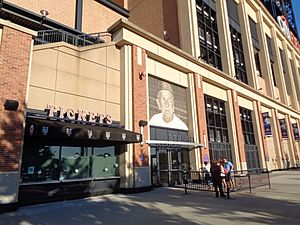
Images for kids
See also
 In Spanish: Casey Stengel para niños
In Spanish: Casey Stengel para niños


